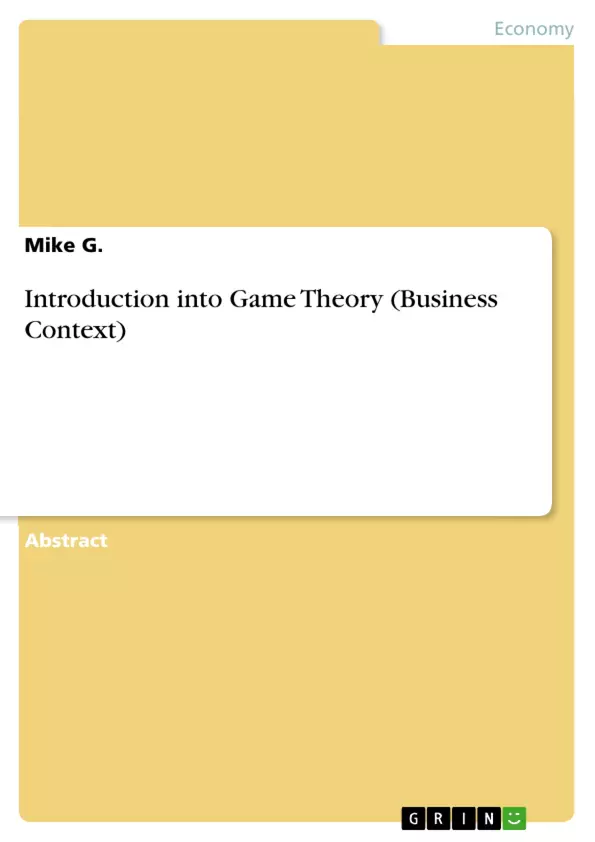From the popular series “Numb3rs” you may know the term “Game Theory”, but do you actually know what this is and how it works? During a six-week session of microeconomics, several basic principles are introduced and applied in the business context. Game Theory deals with the optimal behavior of rational decision makers in a simplified surrounding. This text deals with the optimal behavior during a second price action and within oligopolistic competition. The basic ideas like the prisoner's dilemma are explained and underlined with real examples to simplify and illustrate the dry mathematics behind it. After reading this text, you will be able to solve certain problems in a simplified surrounding by your own and will perceive the world at least a little bit more rational.
Inhaltsverzeichnis (Table of Contents)
- Introduction into Game Theory
- Goals of Game Theory
- Game is strategic interaction between rational players with conflicting interests.
- Blue-prints of a game description.
- Practical example: Stone – Scissor – Paper
- First mover vs. late mover.
- Static Games with discrete payoffs (simultaneous actions).
- Prisoner's Dilemma.
- Advertising Game
- Problem/Characteristic of the prisoner's dilemma.
- The original construction around the prisoner's dilemma.
- Specifics on Nash equilibrium.
- Games with discrete payoffs
- Static Games with continuous payoffs.
- Numerical Example: Advertising Game.
- Zero-sum games and mixed strategies.
- Explained by the \"Matching Pennies” example.
- Directly conflicting interest are the reason:
- Sequential Games (actions are followed by each other).
- Explained by the Market Entry Game example.
- To show this sequential decision making process, the concept of Nash equilibrium has to be redefined.
- Subgame Perfect Equilibria (SPE).
Zielsetzung und Themenschwerpunkte (Objectives and Key Themes)
This text introduces the basic principles of game theory and applies them to business contexts, specifically focusing on optimal behavior in a second price action and within oligopolistic competition. The text utilizes real examples to illustrate the mathematical concepts, with the aim of providing readers with the ability to solve certain problems in a simplified environment and gain a more rational understanding of the world.- Optimal behavior of rational decision makers in a simplified environment.
- Analysis of strategic interactions, especially in the context of competition between companies.
- Prediction of human behavior and market outcomes.
- The Prisoner's Dilemma and its implications for decision-making.
- Nash Equilibrium and its application in various game scenarios.
Zusammenfassung der Kapitel (Chapter Summaries)
The first chapter introduces the concept of Game Theory and its applications in business contexts. It explores the goals of game theory, which include analyzing strategic interactions, predicting human behavior, and determining rational behavior. The chapter also outlines the key elements of a game description, such as players, rules, actions, outcomes, and payoffs. The second chapter delves into static games with discrete payoffs, focusing on the Prisoner's Dilemma. This chapter examines the creation of a static payoff matrix and explores the concept of Nash equilibrium. It also analyzes the characteristics and implications of the Prisoner's Dilemma. The third chapter discusses static games with continuous payoffs, using a numerical example of an advertising game. This chapter introduces the concept of best response functions and demonstrates how to identify the Nash equilibrium in a continuous payoff scenario. The fourth chapter focuses on zero-sum games and mixed strategies. The chapter uses the "Matching Pennies" example to illustrate situations where pure strategies fail to exist. It introduces the concept of mixed strategies and explores how to calculate the optimal choice of players in such scenarios. The fifth chapter explores sequential games, where actions are followed by each other. The chapter utilizes the Market Entry Game example to demonstrate the importance of considering the rational reactions of players in sequential decision-making processes. It introduces the concept of subgame perfect equilibria (SPE) and explains how to determine the best decision path through backward induction.Schlüsselwörter (Keywords)
Game theory, strategic interactions, rational decision-makers, Nash equilibrium, Prisoner's Dilemma, oligopolistic competition, mixed strategies, sequential games, subgame perfect equilibria, best response functions.- Citation du texte
- Mike G. (Auteur), 2017, Introduction into Game Theory (Business Context), Munich, GRIN Verlag, https://www.grin.com/document/366933



